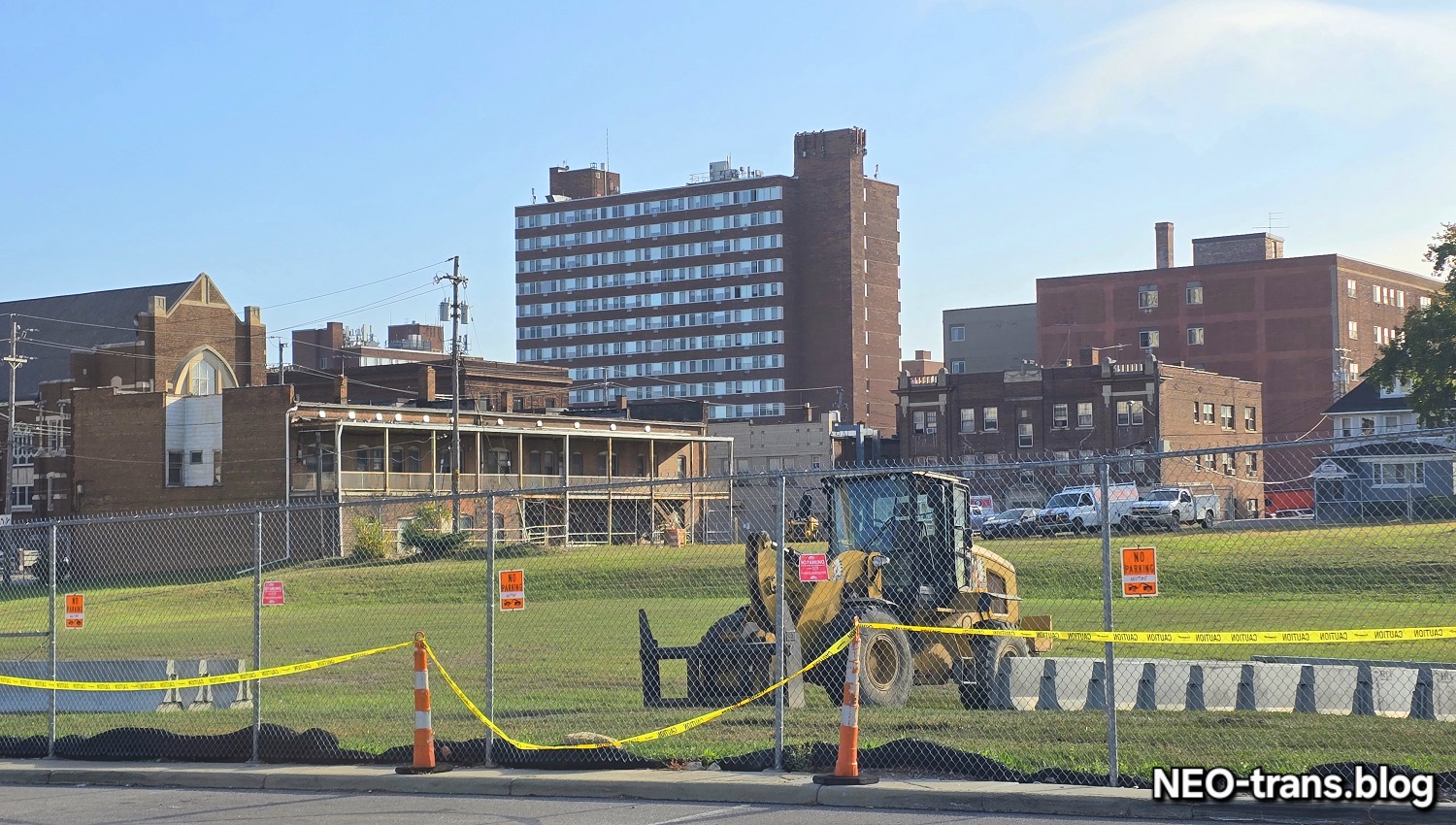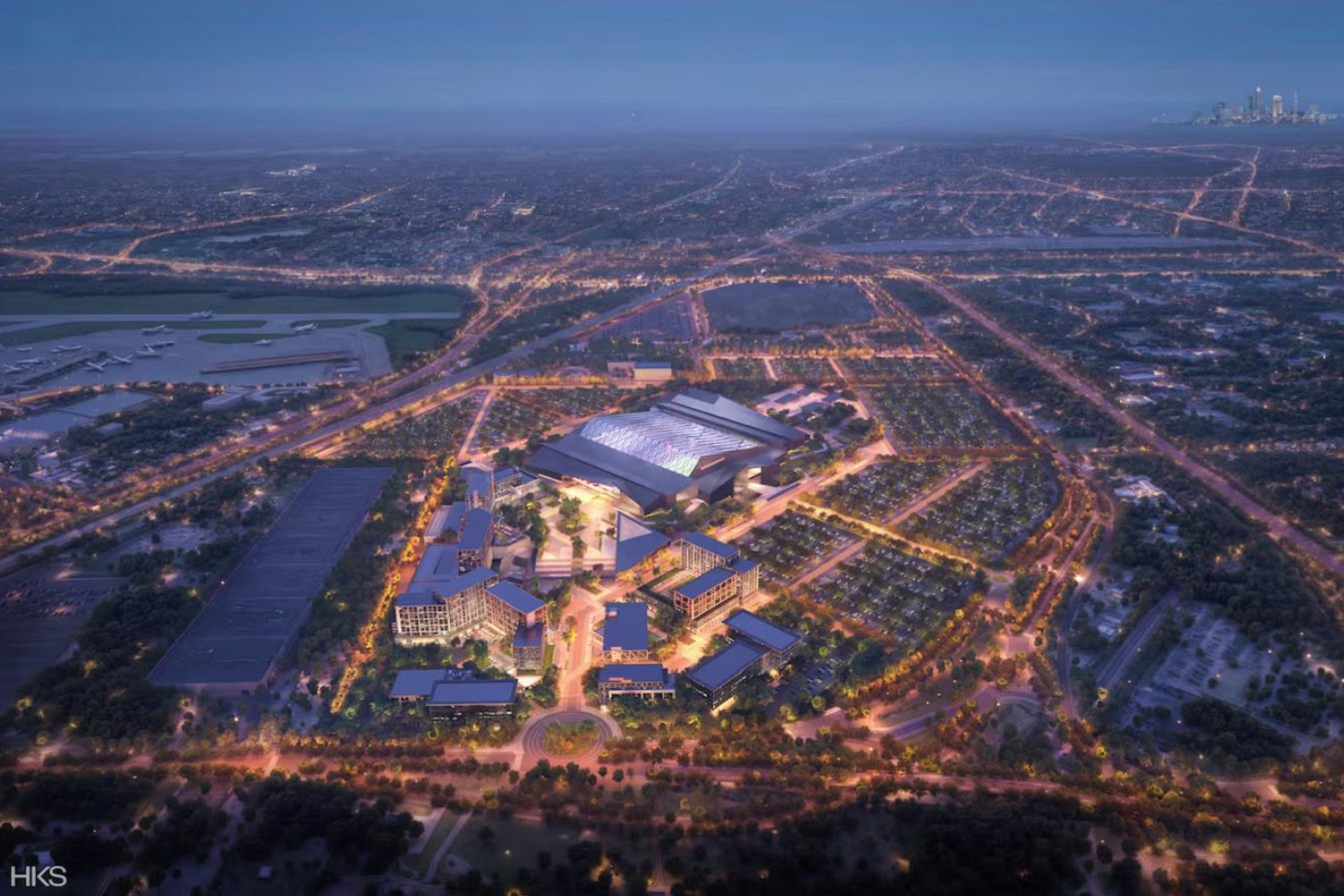Cleveland Officials Want the Browns to Consider Burke Lakefront Airport as a Stadium Option
by Ken Prendergast, NEOTrans | Sep. 5, 2024 | 4:45 PM
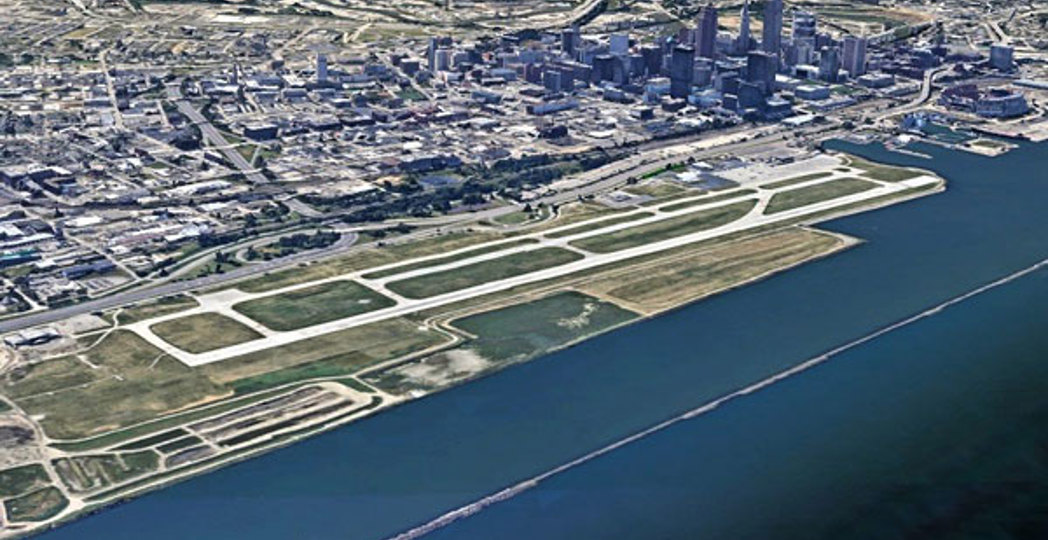
This article was published as part of an exclusive partnership with NEO-trans.blog.
Two key public officials have, in recent days, suggested that Burke Lakefront Airport be closed down and replaced by a new Cleveland Browns Stadium and supportive developments, parking and public spaces. But if such an idea evolves into a serious project, it would also likely require making interim repairs to the existing stadium.
Cuyahoga County Executive Chris Ronayne and Cleveland City Council President Blaine Griffin both said in various media in the past week that they would like Burke to be part of the discussions for a stadium location. Ronayne said it on the social media platform X and Griffin said it during the Ultimate Cleveland Sports Show on YouTube.
While neither man is directly involved in stadium negotiations — Cleveland Mayor Justin Bibb’s administration and the Haslam Sports Group, owners of the Cleveland Browns football team are — both men are key decision makers on public-sector financial packages that could ultimately fund roughly half of a stadium’s costs.
Jimmy and Dee Haslam have instead expressed a preference for relocating Browns home games to a new $2.4 billion domed stadium they would build in suburban Brook Park, surrounded by a sea of parking and $1.2 billion worth of hotels, apartments, shops and restaurants that could generate big money for the Haslams. An alternative $1.2 billion plan for renovating the existing Downtown stadium has not been shared by the Haslams.
The Haslams wanted to build Downtown something similar to what it is proposing for Brook Park but couldn’t find enough land or get vertical clearances from the Federal Aviation Administration (FAA) owing to the proximity of Burke’s flight path, Griffin said. Cleveland has offered 3,700 city-owned parking spaces to the Haslams for stadium events. But the Haslams want more like 20,000 parking spaces from which they could generate lots of revenue.
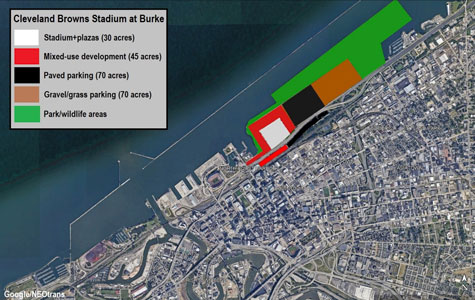
Photo Caption: Burke Lakefront Airport has all the land the Haslam Sports Group could want for its stadium, parking and development — and then some. It would leave enough room for significant park, recreation and natural settings (Google/NEOtrans).
Ronayne told NEOtrans he would have more to discuss on the subject after the Labor Day weekend. But he’s made no secret about where he believes the stadium should be located — somewhere Downtown, preferably on the lakefront where the team has played for eight decades.
“We hope they (Haslams) will join the conversation — rejoin the conversation that frankly they helped get started about a vision for the future with the Browns on the lakefront,” said Ronayne at an Aug. 12 press conference.
He was referring to the city’s Downtown lakefront plan, likely soon becoming a project, which was actually instigated by the Haslams who sought multiple lakefront high-rises surrounding a renovated stadium, possibly capped with a roof. But the FAA nixed those features.
“There’s a quiet chorus seeking it,” said Griffin in a phone interview with NEOtrans, referring to a consideration of Burke. “I thought it might be a good location to consider for building a stadium. I believe that there is a way to extend the life of the present stadium until we really figure out how we want to move forward.”
An October 2023 Osborn Engineering audit of the stadium said its building systems will need $117 million in capital repairs over the next 10 years. The facility audit is required every five years by the Browns and the city as part of the team’s current lease. It A $3.5 million emergency repair was approved by City Council earlier this month — two years after $10 million in repairs were made.
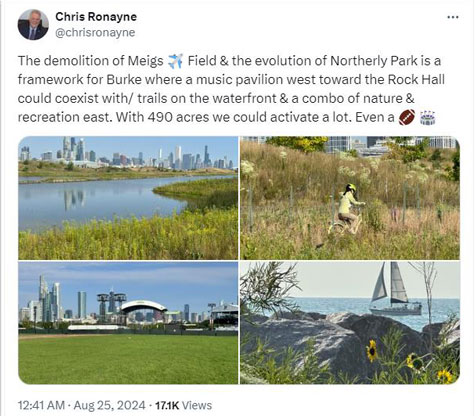
Photo Caption: On social media, Cuyahoga County Executive Chris Ronayne teased the idea of putting Cleveland Browns Stadium at Burke Lakefront Airport (X).
As part of an alternative $1.2 billion stadium renovation plan by the Haslams, they conducted a facility assessment which reportedly said the stadium needed $400 million worth of basic structural repairs were needed just to keep the facility open. That assessment hasn’t been shared with the public or even with City Council, Griffin said.
NEOtrans sought comment from the Bibb Administration and the Browns on putting the stadium at Burke Lakefront Airport. While NEOtrans’ e-mails to Peter John-Baptiste, chief communications officer for the Browns and the Haslams, and Bibb’s Press Secretary Marie Zickefoose were opened, neither responded prior to publication of this article.
“We do not take the stadium decision lightly, and have been working diligently with city, county and state officials to consider all opportunities,” said the Browns and Haslams’ Chief Operation Officer Dave Jenkins in an Aug. 7 letter to fans. “We need to be bold, we need to be innovative, and we need to take advantage of this unique moment to create a transformational project not only for our fans, but for Cleveland, the Northeast Ohio region and the State of Ohio.”
Earlier this month, Bibb publicly released details of the city’s proposal to fund $461 million of a planned renovation of the city-owned Cleveland Browns Stadium on the Downtown lakefront. It would use existing stadium related-revenues to fund the issuance of bonds and not touch general fund money that pays for city services.
Ronayne is critical of the Haslams’ Brook Park stadium proposal for which he said the county was asked to provide provide $300 million in cash and $300 million in bond issuance. He said the county has many other big capital projects in the works including a new jail complex in Garfield Heights, a Downtown courthouse and possibly having to guarantee MetroHealth’s bond debt for its campus redevelopment.
One of the biggest issues for the Haslams is parking revenue, according to multiple sources. The Brook Park site measures 176 acres and would accommodate a domed stadium, supportive development and tens of thousands of parking spaces. Burke Lakefront Airport is 490 acres and growing, as the site is where the Army Corps of Engineers deposits sediment dredged from the navigable Cuyahoga River and Cleveland harbor.
A stadium and its surrounding plazas and staging areas would likely take up about 20-30 acres. Surface parking for 20,000 cars could need up to 140 acres. Stadium-area development could soak up 1 acre or 50. Those could all be easily accommodated at the Burke Lakefront Airport site and still have hundreds of acres left over for park land, recreation and lakefront wildlife areas. Griffin said the most toxic soil was at Burke’s west end which is a closed garbage landfill.
But Ronayne said the FAA won’t allow Burke’s closure unless another airport in the region was expanded to take over Burke’s status as a Reliever Airport. Every major commercial airport has an FAA-designated Reliever Airport and Burke is Cleveland Hopkins International Airport’s reliever. Two Midwest airports that were recently closed — Chicago’s Meigs and Cincinnati’s Blue Ash — were not relievers.
Burke’s main runway is 6,600 feet long, 150 feet wide while Cuyahoga County Airport’s only runway is 5,500 feet long, 100 feet wide, according to AirNav.com. Burke also has a second runway that’s 5,200 feet long, 100 feet wide but has limited operations. The same Web site also noted that Burke had nearly 53,000 flight operations in 2022 while Cuyahoga County had just under 23,000.
In a 2005 long-range plan for Cuyahoga County Airport, it noted that aircraft operations in 2003 totaled 69,540 flights. It also forecasted that flight operations would grow to 83,510 in 2025. Instead, use of Cuyahoga County Airport fell dramatically. If all of Burke’s aircraft operations were moved to Cuyahoga County’s, the combined total would still be less than what was forecast for next year.
That long-range plan recommended lengthening the runway to 6,000 feet by putting Bishop Road below it in a tunnel. It also suggested adding runway safety areas that meet FAA-required design standards, new corporate hangars and apron expansion along the runway, adding hangars to the south side of the airfield, and providing features to reduce noise for airport neighbors.
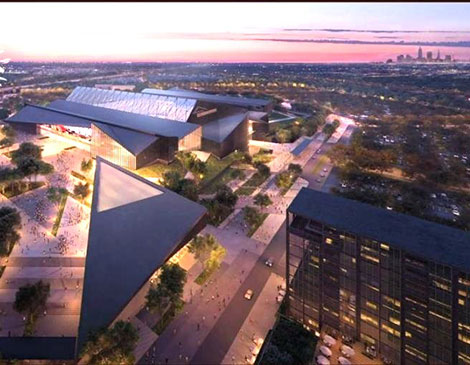
Photo Caption: In Brook Park, the Haslam Sports Group proposes to build a domed stadium, supportive development and a sea of parking lots on 176 acres for $3.6 billion. Even more land is available at Burke Lakefront Airport — if another airport is expanded to accommodate Burke’s reliever airport features (HKS Architects).
The Cleveland Browns have a 30-year lease with the city for the use of the current stadium which expires after the conclusion of the 2028 football season. So a new or renovated stadium with a new lease would have to be available prior to the 2029 season in which the first games are played in August. That suggests that new construction would have to start in 2026 or renovations in 2027.
“Both sides have a sense of urgency to put this to bed,” Griffin said, adding that a rushed effort would produce less-than-desirable results. He referred to the current stadium, the development of which was rushed to bring football back to Cleveland before the end of the 1990s after the old Browns team moved to Baltimore in 1996 and were named the Ravens.
Jenkins said the Haslams seek “a long-term stadium solution that creates a world-class experience for our fans and positively impacts Northeast Ohio.”
“This is the place to invest and reinvest in here in Downtown Cleveland,” Ronayne said. “Again, not with any animus toward the Brook Park model but this is one that works. I was asked by the Haslam Sports Group ‘where do you think this thing should be’ and I said ‘here’ (Downtown).”
For more updates about Cleveland, sign up for our Cleveland Magazine Daily newsletter, delivered to your inbox six times a week.
Cleveland Magazine is also available in print, publishing 12 times a year with immersive features, helpful guides and beautiful photography and design.

Ken Prendergast, NEOTrans
Ken Prendergast is a local professional journalist who loves and cares about Cleveland, its history and its development. He has worked as a journalist for more than three decades for publications such as NEOtrans, Sun Newspapers, Ohio Passenger Rail News, Passenger Transport, and others. He also provided consulting services to transportation agencies, real estate firms, port authorities and nonprofit organizations. He runs NEOtrans Blog covers the Greater Cleveland region’s economic, development, real estate, construction and transportation news since 2011. His content is published on Cleveland Magazine as part of an exclusive sharing agreement.
Trending
-
1
-
2
-
3
-
4
-
5







